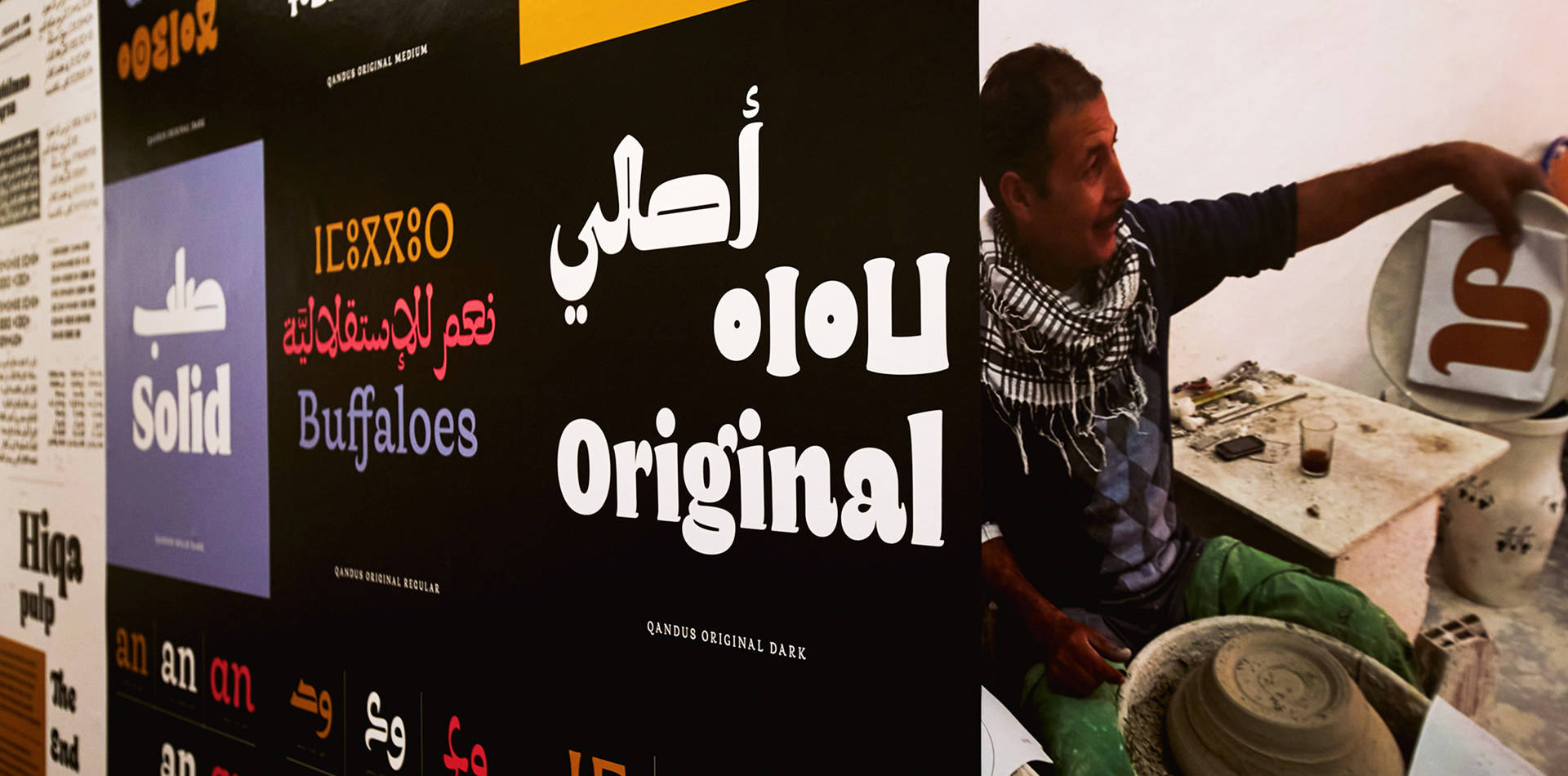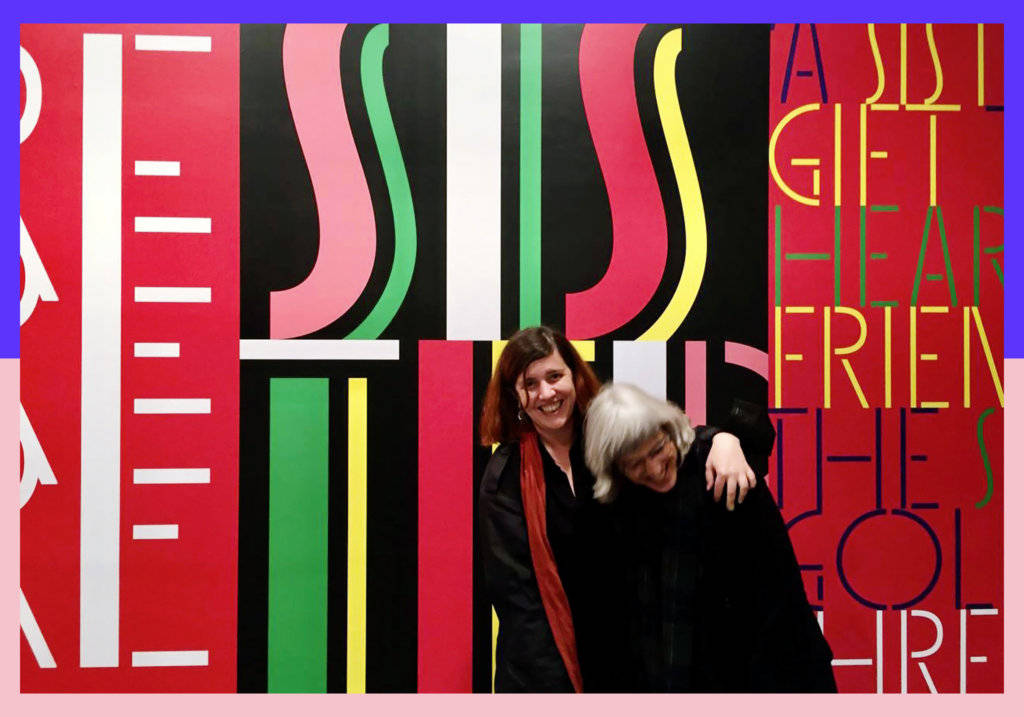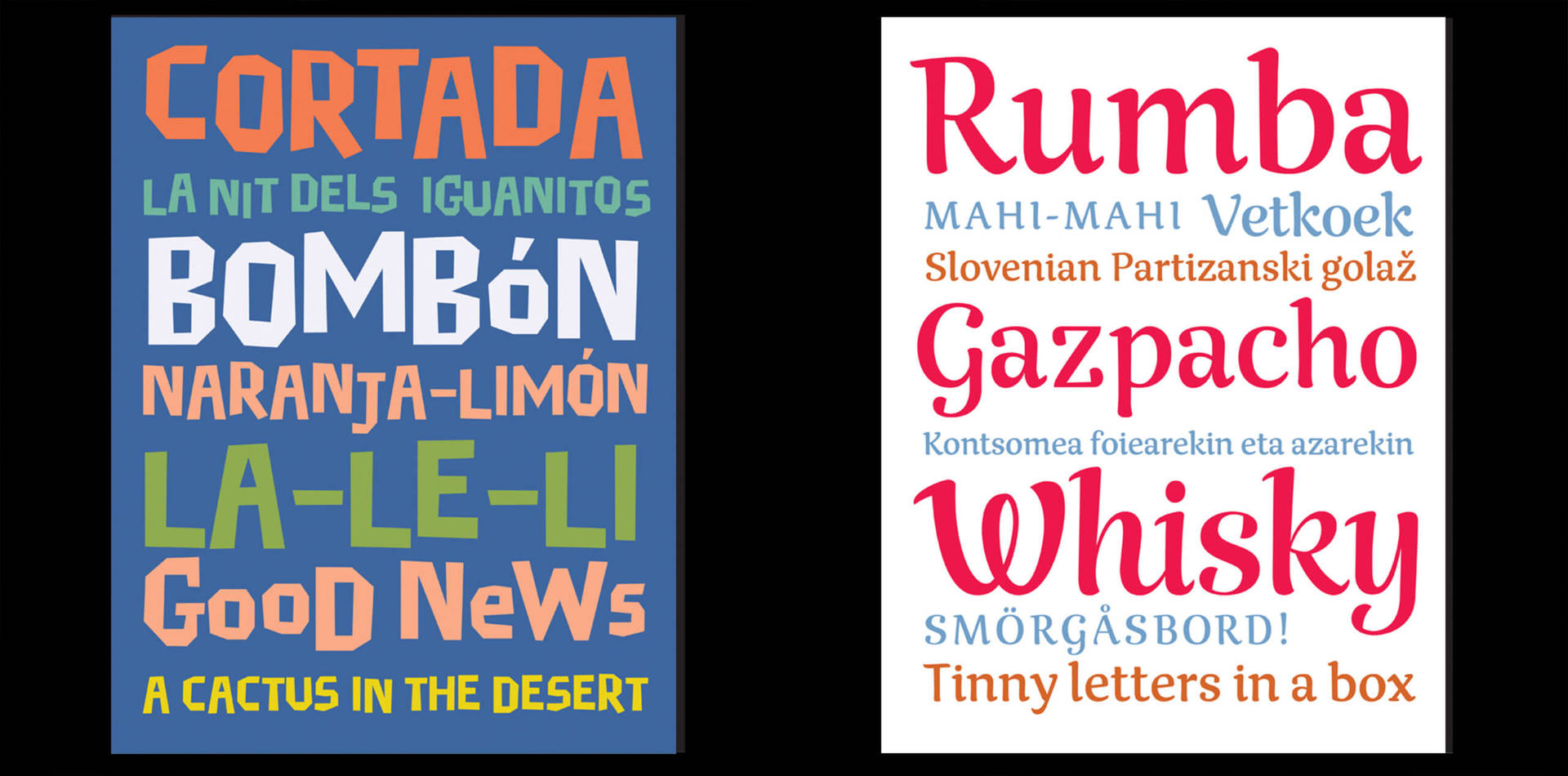Laura Meseguer & Eider Corral by Camila Cardeñosa
A few months ago, the exhibition ‘The beautiful people’ was shown in Barcelona, Spain. It was the first solo exhibition of the great Spanish designer and typographer Laura Meseguer, curated by her friend and former student Eider Corral. ‘Laura is the heart of the exhibition, and Eider is the brains behind it’ observed in one of the many articles written about the collaboration of these two great women.
Laura is one of the first female digital typographers to become well known in the industry. Her fonts can be found on Type-Ø-Tones foundry, which was founded by Laura together with Joan Barjau, Enric Jardí and José Manuel Ucrós in 1990. In addition, Laura’s work can be seen in many cultural projects around Spain. All told, she is a great reference point for women who want to pursue a career in typography today.
Eider is a talented graphic designer from Bilbao Spain, recognised for her impeccably crafted cultural and editorial projects. The books designed in her studio would be coveted by any designer. I personally would like to have them all on my bookshelves; the level of finesse and exquisite use of typography is enviable.
Our talk was full of insights, discussion and without doubt, food for thought. We talked in depth about contemporary feminism. According to Eider: “Working in collaborations, having empathy for each other… not producing for the sake of producing, but always seeking to generate knowledge… this is ‘contemporary feminism’”. More specifically, in terms of the exhibition, it was important to her to display a female way of working: “we, as women, no matter in which field we work find ways to put relationships first. Laura is not unique in doing this, but she is a perfect role model to follow.
These concepts of contemporary feminism are the common themes that run through the exhibition, most visibly in ‘Sisters’, a piece that for Laura and Eider, “represents the search for feminine values: sharing, collaborating, interacting, caring. (‘You are my sister’)”. They both believe strongly that if we as women, continue to join forces, make ourselves visible, collaborate and empathise with everyone around us to build networks that are safe spaces to share and help each otherwe will finally be able to break down the limitations patriarchy has imposed on us and find equity in the world.
Laura and Eider have each followed inspirational career paths that crossed at different points over the years. Learning about their individual stories has been a very enriching experience for me, and today, a few months on, I continue to reflect and think about the things we discussed.
Laura Meseguer
When did you realise that you were interested in letters and that you wanted to work as a typographer and what steps got you where you are?
I am a graphic designer. I became a typographer at the moment I started working on selecting fonts and using them, to design a logo or books, for example. That led me to study letterforms and want to design them, and that’s how I started with Type-Ø-Tones. A few years later I felt that I needed to deepen my skills and knowledge and that is why in 2003 I enrolled in Type & Media, the specialized master’s program of the KABK (Royal Academy of Art)in The Hague. From there, and through designing some custom fonts, I became a type designer.
What do you enjoy most about being a type designer?
The challenge of transferring a concept deploying the functional and emotional attributes of the shapes of letters.
In Óscar Guayabero’s text, he describes your job as a teacher as that of a mediator and companion. What do you enjoy the most about being a teacher?
Sharing and debating doubts and solutions with students as part of the creative process is very enriching for both sides.
Being a woman, has it impacted your career?
For some time, I was the only female typeface designer of the digital age in our country., That made me feel a certain responsibility “to do it well.” Until then it was a profession almost exclusively for men and when a woman appeared, she became the focus of attention. Today, fortunately, there are many more designers and actions and collectives that are bringing visibility to work done by women both in graphic design and in the field of typography, p. and. Alphabettes, Femme type, etc
In your experience, do you think there is equity for men and women in the world of design?
In answering the previous question I have already indicated my answer to this. There are more and more women in the field because more and more women are being trained as designers, comparable with many other professions. This is a reflection of society, since men and women access education under the same conditions. But later society pushes women towards specific roles, to the extent that they disappear. Society still needs to facilitate equal opportunities.
If you could go back and start over, what advice would you give each other?
Trust more in your intuition, try to focus more energy on one discipline and not disperse it across many.For many years I worked exclusively in graphic design without dedicating enough time to my passion, which is typography.
Many people in the creative industry suffer from imposter syndrome and doubt their abilities. Have you experienced this?
We all create our own expectations. Feeling that you are not good enough, competent or capable… is something you demand of yourself. But pressure is also exerted by the professional environment, and it is very possible that women feel it more deeply. I think that we should stop worrying about the opinion of others as it can waste a lot of energy.
The vernacular typography photo collection on your Instagram is wonderful and inspiring. Tell us about this exercise of collecting and observing letters in the streets. Is it part of your inspiration process?
I really enjoy myself wandering around and in the process I discovered the diversity of my environment, in the landscape, in architecture and also in signs and vernacular expressions of language, which change from one place to another and contribute to their identity. The moment I started to travel more frequently I realized that and started collecting and sharing those photos. I thought that doing it on instagram would serve as an archive, as inspiration for me and for others as well.
Have you had a female role model who helped you grow in your career?
As a graphic designer Pati Núñez, without a doubt. She was a reference point since I studied at La Llotja until I had the opportunity to work with her.
What designer, artist, photographer, creative inspires you?
- Sister Corita Kent — corita.org
- The research work being carried out by Fiona Ross and Alice Savoie at the University of Reading, which will serve to rewrite the history of typography. Women in Type, ‘A social history of women’s role in type drawing offices.’— research.reading.ac.uk/women-in-type/
Eider Corral
When did you realise that you were interested in design and what field did you want to work in as a designer?
I remember clearly that it was in the third year of my journalism degree. I started collecting flyers from clubs and concerts I went to and soon I started designing flyers for the parties my friends organized. It wasn’t until a few years later that I started my specific training in design and typography.
Can you tell us about your career so far. What steps did you get to where you are?
I started designing in a self-taught way planning to go through school afterwards. I worked in some studios in Barcelona but I soon established myself as a freelance designer and started working closely with different record labels. I would say that this was where I grew up. And from there, little by little, I have been forging a path in which I feel comfortable, collaborating with institutions and artistic and cultural projects, which is where I have done most of my work.
What do you enjoy most about being a designer?
The part that interests me the most is always the translation or transition from a conceptual framework to a graphic idea. I am very interested in these mechanisms because they mix design with other disciplines and knowledge.
Laura was your teacher. It must be very exciting to curate the work of one of your teachers. How did you face the challenge?
It has been very exciting. Laura is a generous and accessible person, and the whole process has been very natural, relaxed and supportive.
Has being a woman impacted on your career either positively or negatively?
I would say that it has impacted on me in different ways. During the first years we were developing as designers in an environment with forms and codes that still depended on the patriarchal organization of things, and those tentacles are very long and often invisible. At this moment I feel that the situation has evolved and there is a sense of common purpose, more or less organized, that is influencing our practice in an integral way and that ideally will help us not only to make ourselves visible but also reshape the environment and ways of working.
In your experience, do you think there is equity and diversity for men and women in the world of design?
I think not yet, but little by little we are on our way. We want to be more present in decision-making bodies, we need to reformulate the canon and review the history of design, vindicating female figures, generating less aggressive and more empathetic environments. Perhaps that is what interests me the most now … not only that our work is more visible but also feminizing the story.
If you could go back and start over, what advice would you give yourself?
Believe more in intuition and be very attentive to self-sabotage.
Many people in the creative industry suffer from imposter syndrome and greatly doubt their abilities. Have you experienced this?
This is precisely what I mean by self-sabotage and how long the tentacles of the system are. The fight, almost always, has started in oneself. And it is by organizing and working together that we are making all of this go away.
Have you had a female role model, or a woman who has accompanied you on this path and helped you grow in your career?
I would say that as a designer Laura has been an important reference point for me, because I was her student and because of how close she has been. And, fortunately, right now I am surrounded by many, many women who inspire me, who I rely on and who I try out ideas on. We are all growing together.
What is the next exhibition you dream of doing?
I would like to continue investigating alternative graphic genre such as fanzines and flyers as a way to communicate alternative views.
What designer, artist, photographer, creative inspires you?
Infinite Pj Harvey, Kae Tempest, Mia Hansen-Løve, Dai Ruiz, Camila Falquez, Ericka Hart. Lately I’m very interested in the intersection between creation and activism.
Exhibition: The Beautiful People

Congratulations on The Beautiful People exhibit. Tell us about it. How was the selection process of Laura’s projects for this exhibition organized?
Laura: The selection of projects is directly related to the exhibition discourse. First, we decided what we wanted to tell, then which projects would be the most appropriate and finally how to adapt them to the La Sala space.
Eider: The seed of the exhibition is extensive conversations and reviews of Laura’s file until we had identified and were reeling off what we wanted to show. We also wanted to promote a certain type of experience. Then we made a translation of that story to the space and characteristics of the exhibition.
In an interview with Eider by Blanc Festival, you talk about feminism in design and about the collaboration between women, who “come together to work and fight,” Can you tell us more about this beautiful idea?
Laura: The feminism of this exhibition is displayed on the one hand through the goal of making the work of women designers more visible and on the other from a direct message in, “Sisters”, a piece in the exhibition. “Sisters” represents the search for properly feminine values of sharing, collaborating, interaction, caring (“you are my sister”) and uses personal experience as a source of inspiration.
Eider: As Laura observes, in addition to making women’s work in design visible or reflecting on what it can represent or if there really is a feminine way to design, we were very interested in understanding the particularities that the feminist movement brought to graphic design. We know that the graphic arts unions were an important field of struggle in the first half of the 20th century and the feminist stamping workshops a context of meeting, vindication and capital empowerment in the 70s. It seemed important to us to value the parallel organization, essentially horizontal and participatory, of all these movements to understand that it continues to be a valid model to rethink and transform the world. It has been this look that has helped us to think and organize the topics and the selection of projects.
Eider, was a student of Laura. How was it working together?
Laura: Eider was my student more than 10 years ago, I remember that she was a fun designer, with an already formed vision of the world and very clear ideas, but at the same time she was a sponge, and that is very stimulating for a teacher Giving and receiving always enriches the process.
Eider: I remember Laura even then as a person in constant evolution, curious and always accessible. I would say that the work process for the exhibition has been a great conversation that took the form of a joint journey through her work and through the different contexts and roles in which, we have related since we have known each other.
Follow:
Visit:
Article by Camila Cardeñosa
Camila Cardeñosa is one of our collaborators who has written and curated a series of inspirational features showcasing Spanish speaking women designers based in Latin America and Europe.












